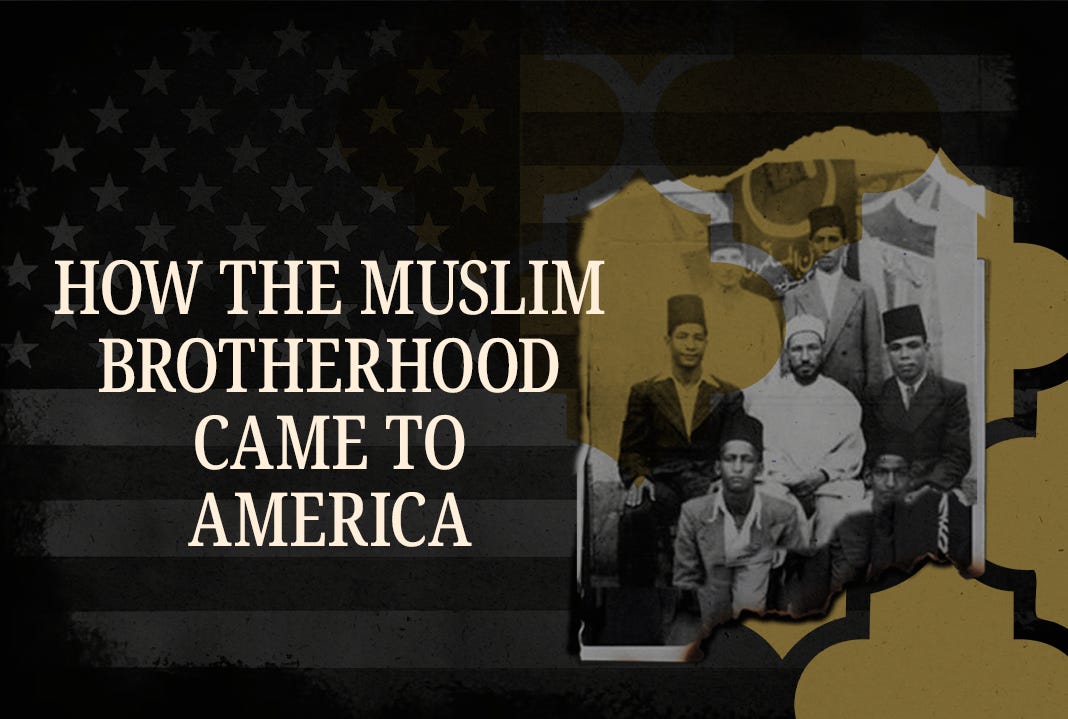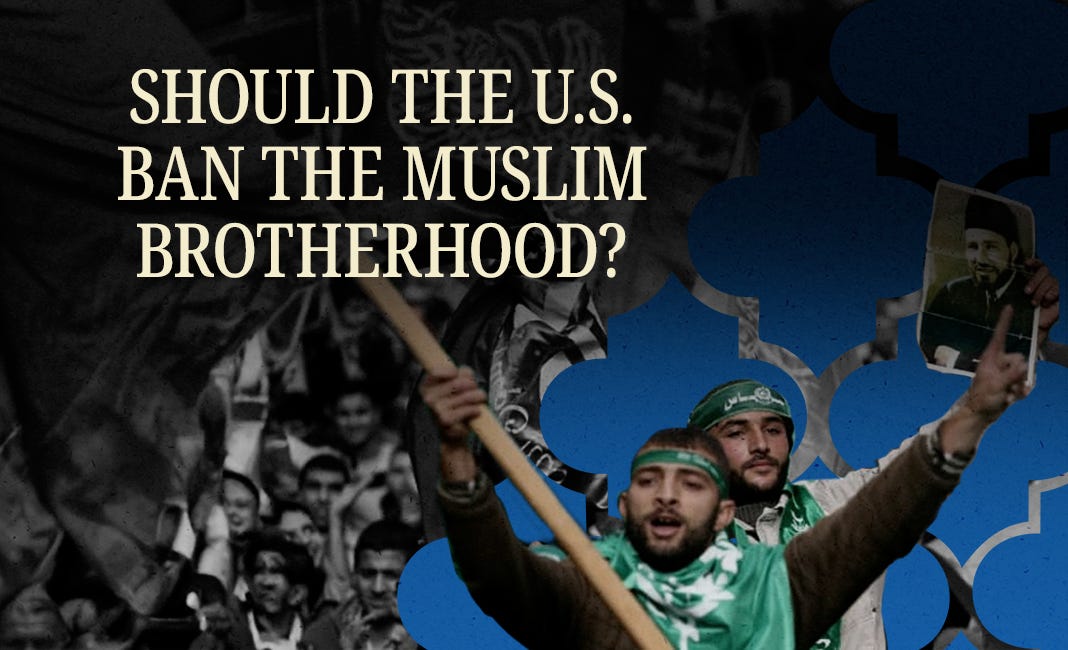How the Muslim Brotherhood Came to America
Lorenzo Vidino reveals how a foreign ideological movement embedded itself into American institutions. His report shows that extremism can thrive when it learns to speak the language of democracy.
As someone who has lived through the consequences of extremist ideology in the Middle East and now studies it in the West, I read Lorenzo Vidino’s The Muslim Brotherhood in America with both familiarity and unease. With the United States now preparing to designate the Muslim Brotherhood as a foreign terrorist organization in a move backed by some Arab allies and long-overdue scrutiny, the timing of this report becomes especially urgent. It is concise but carries far-reaching implications, both polemic and evidence-based, and courageous in confronting one of the most misunderstood ideological networks of our time.
Published by the Program on Extremism at George Washington University, the report traces how an Egyptian-born movement found new life in the United States not through violence, but through institution-building. Vidino begins in the 1950s and 1960s, when thousands of Muslim students arrived in the United States seeking education. Among them were young men influenced by Islamist ideologues like Hassan al-Banna and Sayyid Qutb, who saw Islam not only as a faith but as a totalizing political system.
In 1963, these students created the Muslim Student Association (MSA) at the University of Illinois, a group that would become the seed of a much larger network. What began as a campus fellowship evolved into a nationwide movement that eventually produced the Islamic Society of North America (ISNA), the International Institute of Islamic Thought (IIIT), and the North American Islamic Trust (NAIT), organizations that to this day serve as the public face of “mainstream” Islam in America.
Vidino’s historical detail is relentless and well-sourced. He highlights figures like Jamal Barzinji, Ahmed Totonji, and Hisham al Talib, three Iraqi Kurds who fled Ba’athist repression and became architects of the Brotherhood’s American infrastructure. Backed by wealthy donors, they founded IIIT in 1980 and promoted the “Islamization of knowledge,” in an attempt to reframe modern disciplines through a theocratic lens.
What makes this report more than just a historical record is its use of internal Brotherhood documents obtained during the Holy Land Foundation terrorism financing trial, the largest of its kind in U.S. history. Among them is the now infamous Explanatory Memorandum, authored by Brotherhood official Mohammed Akram, which describes the organization’s goal in North America as a “civilization jihadist process” to “destroy Western civilization from within.” This is not conjecture or propaganda. It is the Brotherhood’s own strategic language, introduced as government evidence in a federal courtroom.
Vidino also details how the Brotherhood leveraged funding to build financial independence and influence. Through the SAAR Foundation in Virginia, a holding company tied to Brotherhood members, millions of dollars flowed into American mosques, schools, and media initiatives. “If they wanted a few million dollars,” one businessman told The Washington Post, “they called the al Rajhis, who would send it along.” This funding created the economic backbone of the Brotherhood’s American presence, a structure that gave the movement longevity far beyond its ideological appeal.
By the late 1980s, the Brotherhood’s focus shifted toward politics. The American Muslim Council (AMC), led by Abdurahman Alamoudi, became a Washington success story. Alamoudi met presidents, advised the Pentagon on Muslim chaplaincy, and was once praised by the FBI as “the most mainstream Muslim in America.” Yet in 2004, he was sentenced to 23 years in prison for his role in a Libyan-financed assassination plot and for channeling money to extremist groups. The case epitomizes Vidino’s larger point that the Brotherhood’s genius lies not in its militancy but in its ability to mask its intentions through the language of moderation and civic engagement.
Perhaps the most revealing part of the report deals with the origins of the Council on American Islamic Relations (CAIR). Drawing on FBI wiretaps from a 1993 secret meeting in Philadelphia, Vidino reconstructs how Brotherhood figures discussed forming a “neutral” organization to defend Hamas’s political interests under an American-friendly image. Present at that meeting were Omar Ahmad and Nihad Awad, who founded CAIR. The transcripts record the participants openly debating how to “speak the language of democracy” to the media while maintaining their ideological loyalties. Within a decade, CAIR had become the most prominent Muslim advocacy group in the United States, even as the FBI formally cut ties in 2008 over unresolved Hamas connections.
Vidino complements these institutional stories with personal testimonies. One is Hussien Elmeshad, an Egyptian who joined the Brotherhood in New Jersey and described its U.S. structure as “a state within a state,” divided into regions, each with its own naqib (leader) and internal hierarchy. Another is Mustafa Saied, an Indian born student at the University of Tennessee who joined the Brotherhood in the 1990s. He recalls the euphoric sense of belonging and the gradual realization that beneath the surface of community work was a totalizing ideology that rejected American pluralism.
These firsthand accounts reveal what Vidino calls the Brotherhood’s “two-level strategy”: outwardly civic, inwardly ideological. It is not a story of terrorism but of influence, of how Islamist ideas can be normalized, professionalized, and embedded in American civil society while quietly maintaining their original goal of social transformation.
So have these organizations truly reformed, or simply rebranded?
For me, this is where the report’s relevance extends far beyond the United States. I have seen how the Brotherhood’s ideas, often wrapped in the language of justice and identity, corrode civic trust and divide societies. In Iraq, Lebanon, and across the Arab world, similar networks framed sectarianism as piety and ideology as authenticity. The American chapter of this story is a softer version of the same impulse to replace pluralism with ideological conformity.
Vidino’s conclusion is measured but deeply unsettling. Many of the organizations he documents have evolved, distanced from their founders, and adapted to a democratic context. But the question remains whether they have truly changed—or whether they have intentionally learned to speak the language of democracy more fluently.
For policymakers, journalists, and scholars, The Muslim Brotherhood in America is required reading. It challenges the notion that extremism must be violent to be dangerous and reminds readers that ideology can thrive under the protection of free societies.
This report is, in every sense, what scholarship should be: polemic in its clarity, rigorous in its evidence, and unafraid to name uncomfortable truths. In exposing how bad ideas travel across borders and adapt to freedom’s soil, Vidino’s work reminds us of a lesson I have learned throughout my own life: censorship does not stop extremism, but understanding it can.
Read
and on whether or not America should ban the Muslim Brotherhood:Should the U.S. Ban the Muslim Brotherhood?
Last week, the Institute for the Study of Global Antisemitism and Policy (ISGAP) hosted a panel featuring Syrian writer Ammar Abdulhamid (one of the coauthors of this piece), Jordanian analyst Ghaith al-Omari, and Haras Rafiq, ISGAP’s Senior Advisor. The event focused on the Muslim Brotherhood’s enduring influence in the Middle East and the United States—specifically its central role in shaping antisemitic narratives across the region. As two individuals who have watched the Brotherhood’s ideology seep across borders and generations, we find this charge difficult to dispute.
Middle East Uncovered is powered by Ideas Beyond Borders. The views expressed in Middle East Uncovered are those of the authors and do not necessarily reflect the views of Ideas Beyond Borders.





Baathism Nasserism and Arab Socialism along with Tanzim in the levantine region. Don't care about the rest
I guess the first question that comes to mind is: so what? People are allowed to organize based on their ideological perspectives so long as they don’t use violence to advance their objectives. I don’t think the Brotherhood makes any sense but they have every right to organize and work towards normalizing their agenda, that is the very definition of pluralism. This article seems like it was written by a Mossad PR firm and while I may not like the Brotherhood, CAIR is a phenomenal organization that helps combat Islamophobia throughout the country and helps Muslims facing discrimination. The only people who don’t like CAIR are Zionists and their allies.